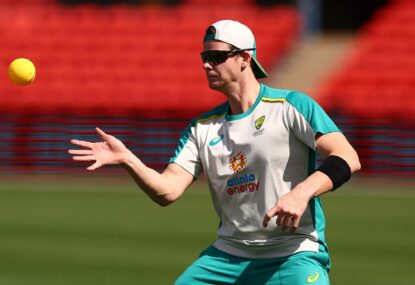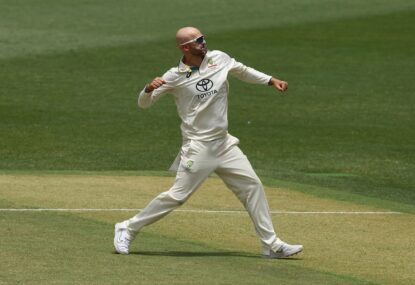With Australia’s tour of Bangladesh just around the corner, a lot of Australian fans are probably wildly ignorant of the opposition.
Some, no doubt, will not even know much about some of the Australian tourists. However, Bangladesh is not a high profile cricket nation in this country. Unlike series against England or South Africa even the biggest names are unknown to many.
(And, to me, they are little more than names attached to players I’ve seen spasmodically. I’m writing this partly as I educate myself on the Bangladeshi players.)
Bangladesh’s most recent Test series was a home series against South Africa. That, too, was over just two Tests. The result was a drawn series, but that is less impressive than it looks at first as weather intervened in both matches.
The second Test barely got started, with less than a day’s play possible in total. The first Test went long enough for Bangladesh to take a first innings lead. Are the Tigers finally starting to realise the promise shown over a few years?
They did make the final eight of the World Cup, but there is a vast difference between that format and playing out five days.
The early forecast, and its a long way out, suggests rain may again intervene in both Tests of the Australian series..
My starting point is to assume that Bangladesh will go with an almost unchanged line up from the South Africa series. Rubel Hussain appears to be over an injury which saw him miss the South Africa Tests and will surely come into the team as the spearhead bowler. The question marks are that he hasn’t played a First Class match since April and his record is surprisingly poor. From what I have seen, I assumed he averaged something closer to 35 with the ball than the 75 he actually does.
That would mean Bangladesh would open the batting with Tamim Iqbal and Imral Kayes. Iqbal has been touted many times a quality player across the formats, and he does average near enough to 40 at Test level after some 42 Tests.
He can score and often looks good, but sticking around for a big score is another matter. Like most players from nations that get few Tests, playing out along innings is something he can struggle with.
Kayes only has half the experience of his partner, and more worryingly half the average. He does have three hundreds, all of which have been scored in Bangladesh. So, on his day, against a depleted Australian attack, in home conditions, he may be able to help his side put together a decent enough start. But even at home he still only averages 31, so his day doesn’t come all that often.
The likely number three is the frustrating but talented Mominul Haque. He may become Bangladesh’s version of Aravinda de Silva, the player who starts the trend of true world-class players and instils the belief that people from that country can make it.
He averages 56 overall in just 17 Tests, and while four of those have been against Zimbabwe his record against them is roughly the same (marginally lower) as his overall average so its not boosted by cheap runs. Like Kayes, all his hundreds have been at home. He is inexperienced for a test number three, but of undoubted quality. He has fallen away this year, as can happen with young players, but was not disgraced against South Africa.
That Mamuhdullah may bat at number four shows the lack of depth in Bangladesh’s batting. Averaging just 31 at Test level over a number of years, Mamuhdullah is the archetype of all that can go wrong with a new Test nation. Asked to do jobs that would not be required at more established nations, Mamuhdullah’s abilities have been swamped by his responsibilities. In the last couple of years his batting has found some more consistency, however he is suited to batting down the order and trundling in with his gentle medium pacers than a key position the batting line up.
Captain and sometimes wicket-keeper Mushiqfur Rahim may well bat at five again. He is not Andy Flower or Adam Gilchrist, and batting this far up the order in a Test team flatters him. With the gloves, from dodgy memory, he is serviceable. With the bat a useful number seven or good number eight. If Australia get to him early, Bangladesh will struggle to compile a meaningful total.
That Bangladesh’s most experienced player (he is due to play his 50th in the second Test) averages just 32 again underlines that there is a lack of proven quality in Bangladesh.
At six, all-rounder Shakid Al Hasan can provide some fight if the middle crumbles. He is in that group of 40-odd Test experience players that Bangladesh have quite a few of now. And his overall average is well above the two players likely to bat above him, pushing 40. The bowling is more than that of a part-timer in this team, with 147 wickets at 33. If conditions are helpful his slow left-arm orthodox may provide a headache for some of the Australians.
Liton Das is likely to keep wickets ahead of Mushiqfur Rahim, although the temptation must be to get another batsman in the side. On the other hand, letting Rahim just bat and captain leaves him free of a burdensome role and perhaps able to score more. The 20-year-old has played just the three Tests, including the South Africa games. He can bat, and played as a specialist batsman in a recent Bangladesh A game, but whether he can do so well enough at Test level may be another question. At 20 years old, Bangladesh are likely to persevere with him regardless.
Nasir Hossain was brought in for the second South Africa Test but due to the weather not got to bowl. I don’t recall seeing him play before, but his numbers suggest he is more of a batting all-rounder. His 17 Tests across four years do not make for good reading.
Mohammad Shahid is one who is a little more familiar. He is likely to open the bowling, although not express and as yet his talents have not realised great returns. He is too old to be considered young and raw, but is inexperienced and hopefully learning. He is capable of producing solid spells, without making breakthroughs. He needs to find a way to take wickets though and at this stage seems more suited to the 50-over game, where batsmen will take a risk, than the 20 wicket game.
Mostafizur Rahman is perhaps the pick of the Bangladeshi bowlers, although with just two Tests under his belt that is jumping the gun somewhat. The 20-year-old left armer does average under 20 at First Class level, although it is hard to judge how that translates given they are largely within the Bangladeshi domestic scene. He is one to watch, both as a potential problem for Australia an emerging talent for many years to come.
Leg-spinner Jobair Hussain is another with little international experience behind him but full of promise. He does bowl some loose stuff, but he also tries to attack the batsmen. Given how some of the Australians played part-time off spinner Moeen Ali in England, could this be a breakthrough series for a young tweaker prepared to take a risk?
Taijul Islam played the first Test against South Africa, but not the second (such as it was). He will come under consideration again as another spinning option. Generally speaking, however, pitches in Bangladesh take turn, but very slow turn. Overloading with spin is an easy trap to fall into. With both Tests likely to be rain interrupted, plus the humidity and a ball which could get scuffed up early on reverse swing might be the order of the day. Bowling genuine cutters and a change of pace, both quicker and slower, could also be vital weapons. Australia will miss Pattinson in this series as much as ever as a result.
Even with an inexperienced side Australia looks too talented for this Bangladeshi team. But if Australia have a Trent Bridge moment – and it was all over in little more than a moment – they could find themselves staring down the barrel at times on this tour.
Two young sides, one starting to rebuild, and one just starting to build the nation’s cricket reputation. Bangladesh versus Australia may well be far from the lopsided contest that it at first reads. Australia should win, and win comfortably, if for no other reason than having a few players who are more used to playing over the journey.
But at home Bangladesh could, and should, have their moments. All played out in prime time. For those of you with pay-TV, enjoy.






































































































